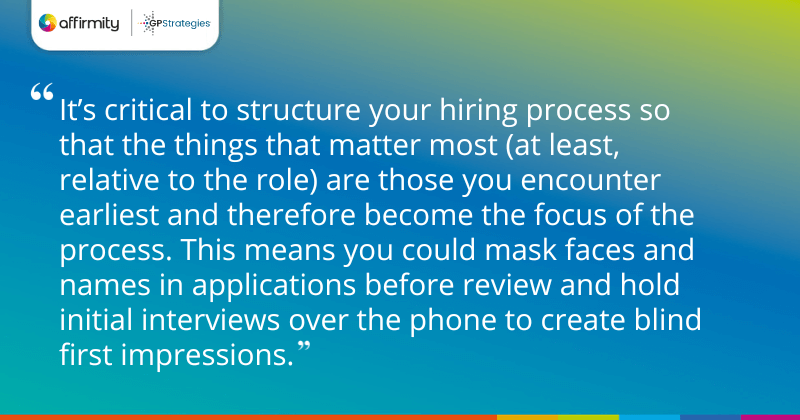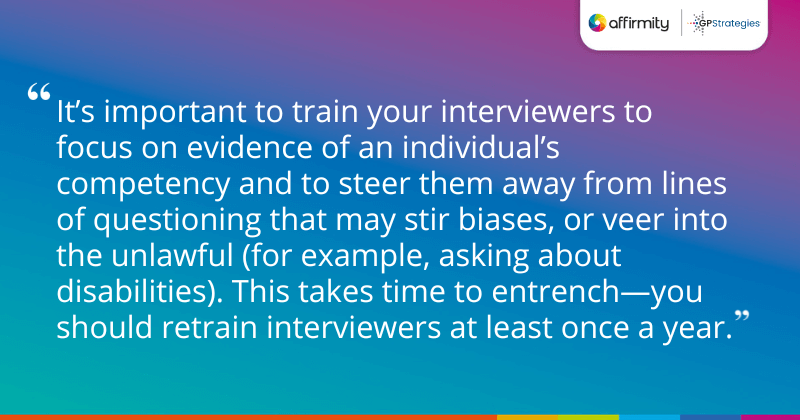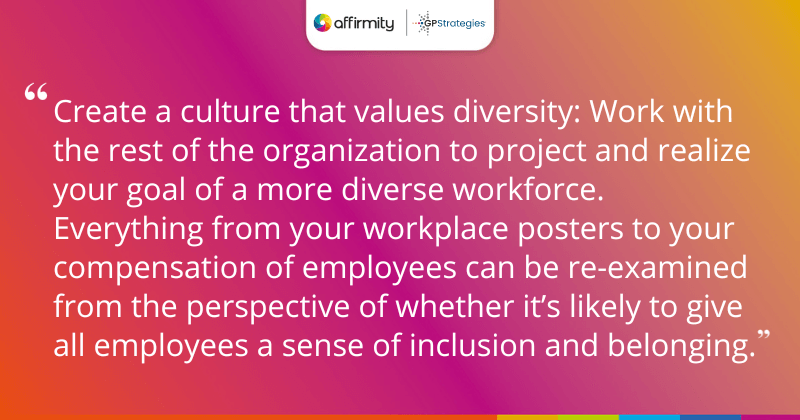Biases are inevitable in the hiring process, but that doesn’t mean that nothing can be done about them. Counteracting bias requires a two-pronged approach: firstly, we can change the way we structure hiring to reduce the opportunities for our biases to be activated. Secondly, we can work to actively recognize and counteract bias when it occurs. Combined with assessment type and interview best practice, here are four areas that you should pay attention to.
1) Structural Changes That Prevent Bias in Hiring
Have you ever noticed how your initial thoughts about a product or experience often determine your final conclusion about it? How a perfectly choreographed opening action sequence sets you up to love an otherwise unexceptional movie, or how a messy rental condo colors your impression of the rest of your vacation?
So it is with people, too—the first thing you notice starts a chain of events that sends your associations toward outcomes negative or positive. Knowing this, it’s critical to structure your hiring process so that the things that matter most (at least, relative to the role) are those you encounter earliest and therefore become the focus of the process. This means you could:
- Mask faces and names in applications before review
- Hold initial interviews over the phone to create blind first impressions. Potentially, you could even do text-only interviews via a chat program
- Actively focus interviewer attention on characteristics required for the job before, during, and after interviews when scores or impressions are recorded
Another option is to use tools that require minimal human judgment to assess candidates. For example, you might use a test that assesses critical thinking skills, or a simulated environment to see how well applicants can use an important piece of software. If you go this route, bear in mind that tools aren’t automatically free of bias. They may be less accessible to specific groups and were ultimately created by humans with their own biases.

PUT DE&I AT THE HEART OF YOUR STRATEGY | ‘4 Great Ways to Help Embed Diversity & Inclusion as a Priority in Your Organization’
2) Recognizing and Countering the Bias of Hiring Professionals
Actively recognizing and countering bias is perhaps less straightforward than it sounds. We can’t simply flip a switch and change our entire conscious and unconscious outlook. Instead, organizations need to start deploying a wide range of countermeasures that slowly tip the balance away from unexamined, placeholder thinking.
- Change how you think: Note that this is as much about the how as the what. Decision-makers should be encouraged to slow down their thinking—pausing at each step to examine their thoughts, taking time to seek feedback from others, and make decisions as a group. This process will expose decision-makers to how others think, allowing them to better consider different perspectives in their decision-making.
- Get involved with other groups: Encourage team members to seek out and support projects and programs that encourage positive images of persons of color, LGBTQ+ people, veterans, individuals with disabilities, and women. These could be within the organization, such as company-sponsored Employee Resource Groups (ERG), or initiatives in the community.
- Counter-stereotypical imagery: Train your brain to recall counter-stereotypical examples that could overwrite more entrenched and less useful ones. If, for instance, when someone says “doctor,” you think male and white, work on thinking about all people you’ve encountered who contradict this.
- Train your decision-makers: Work with an external provider of unconscious bias training, such as Affirmity’s PDT Global, who focuses on cognitive processes, behavioral outcomes, and change, while helping employees develop a broad understanding of biases and their effects.
- Create a culture that values diversity: Work with the rest of the organization to project and realize your goal of a more diverse workforce. Everything from your workplace posters to your compensation of employees can be re-examined from the perspective of whether it’s likely to give all employees a sense of inclusion and belonging.
FURTHER READING | ‘5 Unconscious Bias Myths and 5 Great Ways to Challenge Them’
3) How Different Assessment Types Can Cause Issues
Different modes of assessment have pros and cons. Some are better than others in finding an ideal candidate. However, they may also be a significant source of adverse impact, be actively avoided by applicants, and/or cost considerably more than other methods.
- Structured interviews: tend to be moderately good at determining effective future employees while resulting in low adverse impact. They’re also more likely to be well-received by interviewees because they’re most familiar with them.
- Integrity tests: are relatively good at finding suitable candidates due to moderate to high validity, but they tend to be poorly received by interviewees. They do, however, have low adverse impact.
- Assessment centers: are great for finding the best of the best, have variable adverse impact, and good perception—but they’re expensive.
- Cognitive ability tests: are very good at uncovering who will be good at various complex tasks, but are bad in terms of adverse impact.
How you administer tests matters too.
- Smartphone-accessible assessments: aremore accessible to more people, but produce lower scores without mobile-first design.
- Gamification: may produce age-related differences based on motivation, practice effects, familiarity, and job-irrelevant psychomotor ability differences.
- Job simulations: often cannot be adapted in the same way that the actual work easily can—even something as simple as text size may not be adjustable.
4) What Does a Best-Practice Job Interview Look Like?
It’s important to train your interviewers to focus on evidence of an individual’s competency and to steer them away from lines of questioning that may stir biases, or veer into the unlawful (for example, asking about disabilities). This takes time to entrench—you should retrain interviewers at least once a year.
Some key ingredients of a best-practice interview are:
- Using standardized interview questions so that applicants get an equal opportunity to demonstrate the required skills and a consistent experience overall
- If the interview results in a score, make sure you define what different levels of competency look like ahead of time
- Using multiple trained interviewers—a diverse set of individuals can help to counteract individual biases. Best practice is to use at least three, and have them discuss the merits of each candidate.
- Ensuring that your questions are overwhelmingly focused on job requirements. While it’s important to build rapport, the kinds of questions you ask on the “walk to the door” matter too.

MORE FROM THE BLOG | ‘5 Inclusive Mindsets That Create Better Businesses for Employees With Disabilities’
Getting Started With Compliance and DE&I—Keep Reading!
Talent acquisition professionals have a critical role in realizing an organization’s diversity, equity, and inclusion (DE&I) goals. In addition to the process changes that we’ve considered above, our complete guide also looks at:
- The legal obligations you face in US employment law, including the importance of ensuring accessibility across every part of your process
- The data management principles that will help you manage risk

